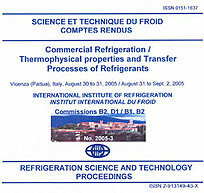
Document IIF
Modélisation de la chute de pression due au frottement lors de l'écoulement de vapeur-liquide dans les microcanaux.
A model for frictional pressure drop during vapour-liquid flow in minichannels.
Auteurs : CAVALLINI A., ROSSETTO L., MATKOVIC M., et al.
Résumé
The authors measured pressure drops during adiabatic flow of R134a, R410A and R236ea inside a flat multiport mini-channel tube with a 1.4 mm hydraulic diameter. The experimental frictional pressure gradients were compared with correlations available in the literature and no correlation was able to predict the gradients in all the experimental conditions. The paper suggests a model for the frictional pressure gradient valid for adiabatic flow or for flow during condensation inside horizontal minichannels of halogenated refrigerants. The proposed procedure takes into account the effect of the entrainment rate of droplets from the liquid film. The model is applied to the annular, annular-mist flow. Comparisons between the authors' data and predicted values show the satisfactory behaviour of the new model. The model is also able to predict experimental frictional pressure gradients measured by Coleman (2000), Zhang (1998), Hirofumi and Webb (1995) and Webb and Ermis (2001). The model can be extended to intermittent flow in minichannels and it is also applied with success to horizontal macrotubes.
Documents disponibles
Format PDF
Pages : 2005-3
Disponible
Prix public
20 €
Prix membre*
Gratuit
* meilleur tarif applicable selon le type d'adhésion (voir le détail des avantages des adhésions individuelles et collectives)
Détails
- Titre original : A model for frictional pressure drop during vapour-liquid flow in minichannels.
- Identifiant de la fiche : 2006-0649
- Langues : Anglais
- Source : Commercial Refrigeration. Thermophysical Properties and Transfer Processes of Refrigerants. Proceedings of the IIR International Conferences.
- Date d'édition : 02/08/2005
Liens
Voir d'autres communications du même compte rendu (140)
Voir le compte rendu de la conférence
Indexation
-
Thèmes :
HFC;
Transfert de chaleur;
Transfert de masse;
Mélanges - Mots-clés : R410A; R134a; Frottement; Comparaison; Coefficient; Microcanal; R236ea; Modélisation; Experimentation; Échangeur de chaleur; Chute de pression
-
Heat transfer coefficient and pressure drop dur...
- Auteurs : DEL COL D., TORRESIN D., CAVALLINI A.
- Date : 13/06/2010
- Langues : Anglais
- Source : IIR/Eurotherm sustainable refrigeration and heat pump technology conference. Proceedings of the Eurotherm Seminar No. 88, Stockholm, Sweden, June 13-16, 2010.
- Formats : PDF
Voir la fiche
-
Pressure loss of evaporation and condensation i...
- Auteurs : MIYARA A., AFROZ H. M. M., HIGUCHI Y.
- Date : 21/05/2006
- Langues : Anglais
- Source : ACRA-2006. Proceedings of the 3rd Asian conference on refrigeration and air conditioning.
Voir la fiche
-
An experimental study on pressure drop and heat...
- Auteurs : GOTO M., INOUE N., EMOTO Y., et al.
- Date : 02/08/2005
- Langues : Anglais
- Source : Commercial Refrigeration. Thermophysical Properties and Transfer Processes of Refrigerants. Proceedings of the IIR International Conferences.
- Formats : PDF
Voir la fiche
-
Numericka simulacija prenosa toplote i pada pri...
- Auteurs : DOBRNJAC M., TURANJANIN V., ILIC G.
- Date : 02/11/2005
- Langues : Serbe
- Source : Zbornik radova pisanih za 36. kongres o klimatizaciji, grejanju, hladenju + CD-ROM./ Proceedings of the 36th International HVAC&R congress + CD-ROM.
Voir la fiche
-
Experimental investigation of convective single...
- Auteurs : OWHAIB W., PALM B.
- Date : 26/08/2002
- Langues : Anglais
- Formats : PDF
Voir la fiche
